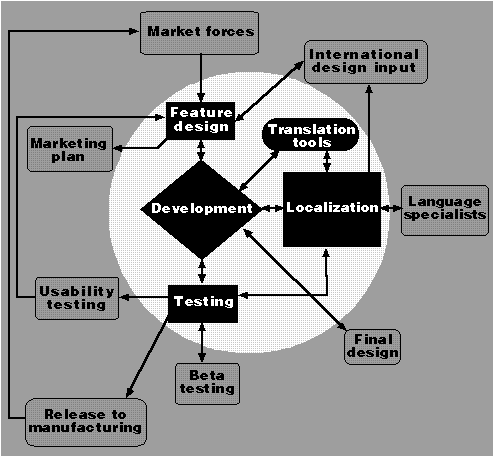
Glossary
The process of creating localized software involves a great deal of communication between different players in a product team. Figure 1-5 below outlines some basic lines of communication and, read from top to bottom, indicates a rough timeline for international product development. During the core phases, the development team provides files to the localization team, which translates text, resizes dialog boxes, and hands files back for compilation, if necessary. The localized executable then goes to the testing team, which reports functionality problems to development and reports user interface problems to localization. All three groups work together to resolve bugs, and the cycle continues.
The least painful kind of localization process is one in which the product team considers international issues during the initial feature design and coding design stages. Market forces, usability tests, and development constraints also affect the design of the product. Translating and testing the code in parallel with development uncovers code and feature design problems early in the process, when it is easier to make changes. Localizing a product is akin to launching a probe to Mars. It's much less involved and much less expensive to adjust the course soon after liftoff. The trajectory might be only a few degrees off when the probe is near Earth, but if you wait until late in the mission to make adjustments, you won't have enough fuel to keep the probe from shooting past Mars by a million kilometers.

Figure 1-5 The localization process.
It is important to "freeze" as much of the user interface and feature design as possible well before the product goes into final testing. Freezing the design means that no more changes will be made before the product ships. Every time a piece of the user interface changes, it has to be retranslated. In addition, the teams in charge of documentation, online help, online tutorials, and marketing collateral might need to update their materials, which also have to be retranslated. Late changes, as you can imagine, cause significant, expensive delays in the release of localized products.